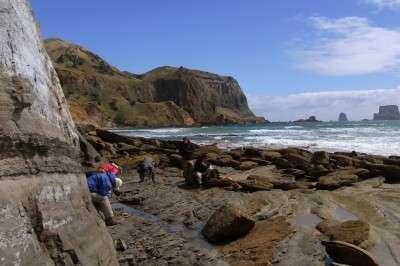Ancient Antarctic treasure trove discovered

(Phys.org)—The chance discovery of a 100 million year old fossil forest on an island east of New Zealand has unlocked new insights on ancient life close to the South Pole.
Large trees in their original living position, early flowering plants, seed cones and rare insects preserved in a rock formation were discovered by researchers in the Chatham Islands. The find reveals what is believed to be the first records of life close to the South Pole during the Cretaceous period, a time of extreme greenhouse conditions 145-65 million years ago.
Led by palaeontologist Associate Professor Jeffrey Stilwell and palaeobotanist Dr Chris Mays from Monash University's School of Geosciences, a research team including Professor David Cantrill from the Royal Botanic Gardens Melbourne made the discovery.
Associate Professor Stilwell said the fossils painted a picture of the formerly unknown life of the Cretaceous period when many southern continents including New Zealand and the Chatham Islands (Zealandia), Australia, Antarctica and South America were still mostly joined together as part of the southern landmass Gondwana.
"One hundred million years ago, the Earth was in the grip of a greenhouse effect – a planet of extreme heat with minimal ice (except in the high altitudes) and sea levels of up to 200 metres higher than today," Associate Professor Stilwell said.
"Rainforests inhabited by dinosaurs existed in sub-polar latitudes and polar ecosystems were adapted to long months of winter darkness and summer daylight.
"Never before have we had evidence about what life existed near the South Pole 90 to 100 million years, or the conditions that life on land experienced.
The discovery, 865 kilometres east of New Zealand, was made in one the most remote fossil locations known in the Southern Hemisphere while researchers were investigating a bone bed further north on Chatham Island and plant remains on nearby Pitt Island.
"Until now there was no modern analogue to this type of preserved forest as close to the South Pole at approximately 1200 kilometres, which is the equivalent distance between Melbourne and Brisbane," Dr Mays said.
"The discovery attests to a completely different type of ecosystem around 100 million years ago revealing the first insights into specific strategies these plants and animals evolved to cope with extreme greenhouse conditions, and months of light and alternating darkness."
Dr Mays said although no immediate comparisons could be drawn, the insights of life on Earth during past greenhouse conditions could provide clues as to how plants and animals will adapt to global warming in the future.
Provided by Monash University















